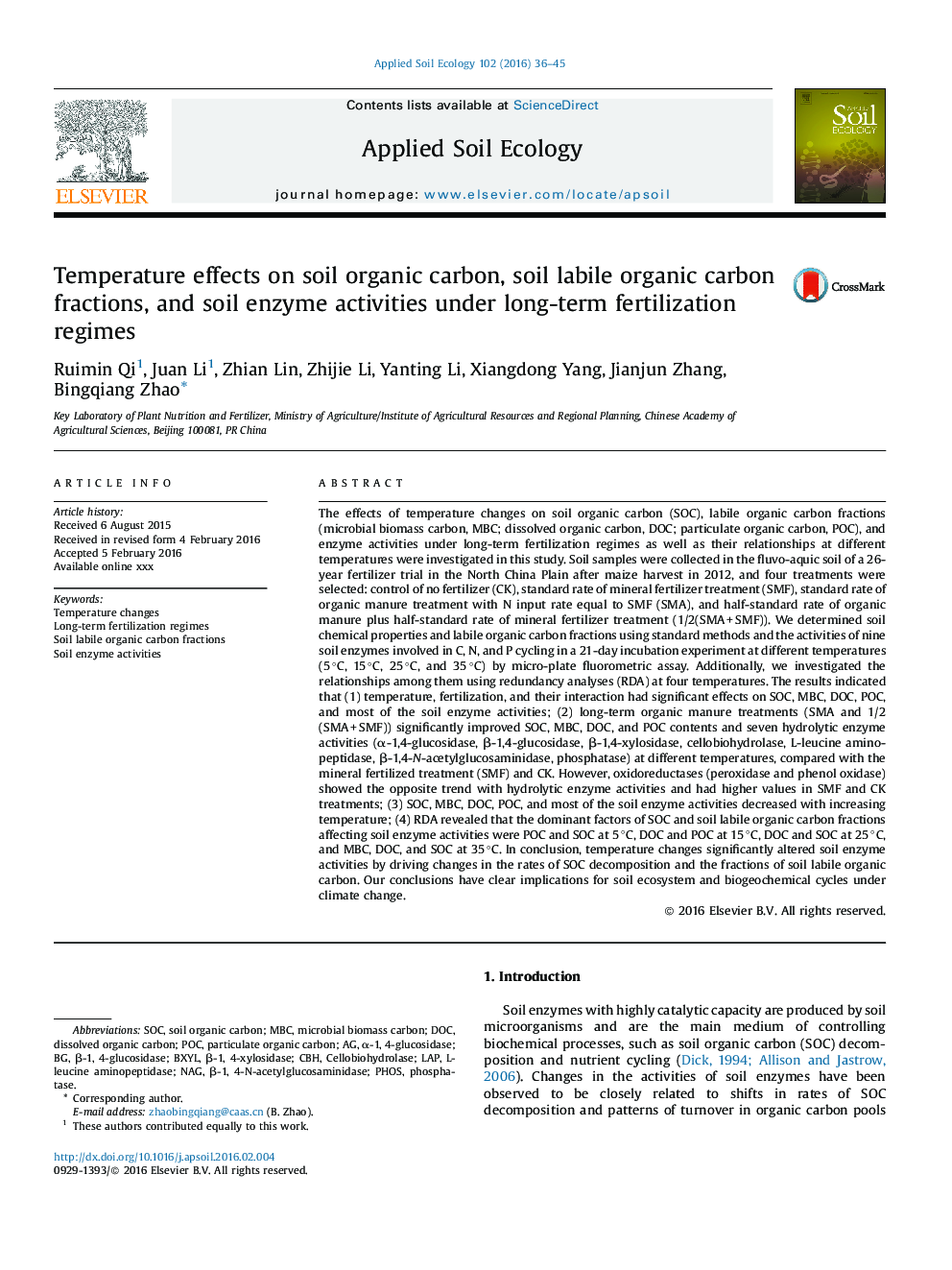| Article ID | Journal | Published Year | Pages | File Type |
|---|---|---|---|---|
| 6297573 | Applied Soil Ecology | 2016 | 10 Pages |
Abstract
The effects of temperature changes on soil organic carbon (SOC), labile organic carbon fractions (microbial biomass carbon, MBC; dissolved organic carbon, DOC; particulate organic carbon, POC), and enzyme activities under long-term fertilization regimes as well as their relationships at different temperatures were investigated in this study. Soil samples were collected in the fluvo-aquic soil of a 26-year fertilizer trial in the North China Plain after maize harvest in 2012, and four treatments were selected: control of no fertilizer (CK), standard rate of mineral fertilizer treatment (SMF), standard rate of organic manure treatment with N input rate equal to SMF (SMA), and half-standard rate of organic manure plus half-standard rate of mineral fertilizer treatment (1/2(SMA + SMF)). We determined soil chemical properties and labile organic carbon fractions using standard methods and the activities of nine soil enzymes involved in C, N, and P cycling in a 21-day incubation experiment at different temperatures (5 °C, 15 °C, 25 °C, and 35 °C) by micro-plate fluorometric assay. Additionally, we investigated the relationships among them using redundancy analyses (RDA) at four temperatures. The results indicated that (1) temperature, fertilization, and their interaction had significant effects on SOC, MBC, DOC, POC, and most of the soil enzyme activities; (2) long-term organic manure treatments (SMA and 1/2(SMA + SMF)) significantly improved SOC, MBC, DOC, and POC contents and seven hydrolytic enzyme activities (α-1,4-glucosidase, β-1,4-glucosidase, β-1,4-xylosidase, cellobiohydrolase, L-leucine aminopeptidase, β-1,4-N-acetylglucosaminidase, phosphatase) at different temperatures, compared with the mineral fertilized treatment (SMF) and CK. However, oxidoreductases (peroxidase and phenol oxidase) showed the opposite trend with hydrolytic enzyme activities and had higher values in SMF and CK treatments; (3) SOC, MBC, DOC, POC, and most of the soil enzyme activities decreased with increasing temperature; (4) RDA revealed that the dominant factors of SOC and soil labile organic carbon fractions affecting soil enzyme activities were POC and SOC at 5 °C, DOC and POC at 15 °C, DOC and SOC at 25 °C, and MBC, DOC, and SOC at 35 °C. In conclusion, temperature changes significantly altered soil enzyme activities by driving changes in the rates of SOC decomposition and the fractions of soil labile organic carbon. Our conclusions have clear implications for soil ecosystem and biogeochemical cycles under climate change.
Keywords
Related Topics
Life Sciences
Agricultural and Biological Sciences
Ecology, Evolution, Behavior and Systematics
Authors
Ruimin Qi, Juan Li, Zhian Lin, Zhijie Li, Yanting Li, Xiangdong Yang, Jianjun Zhang, Bingqiang Zhao,
